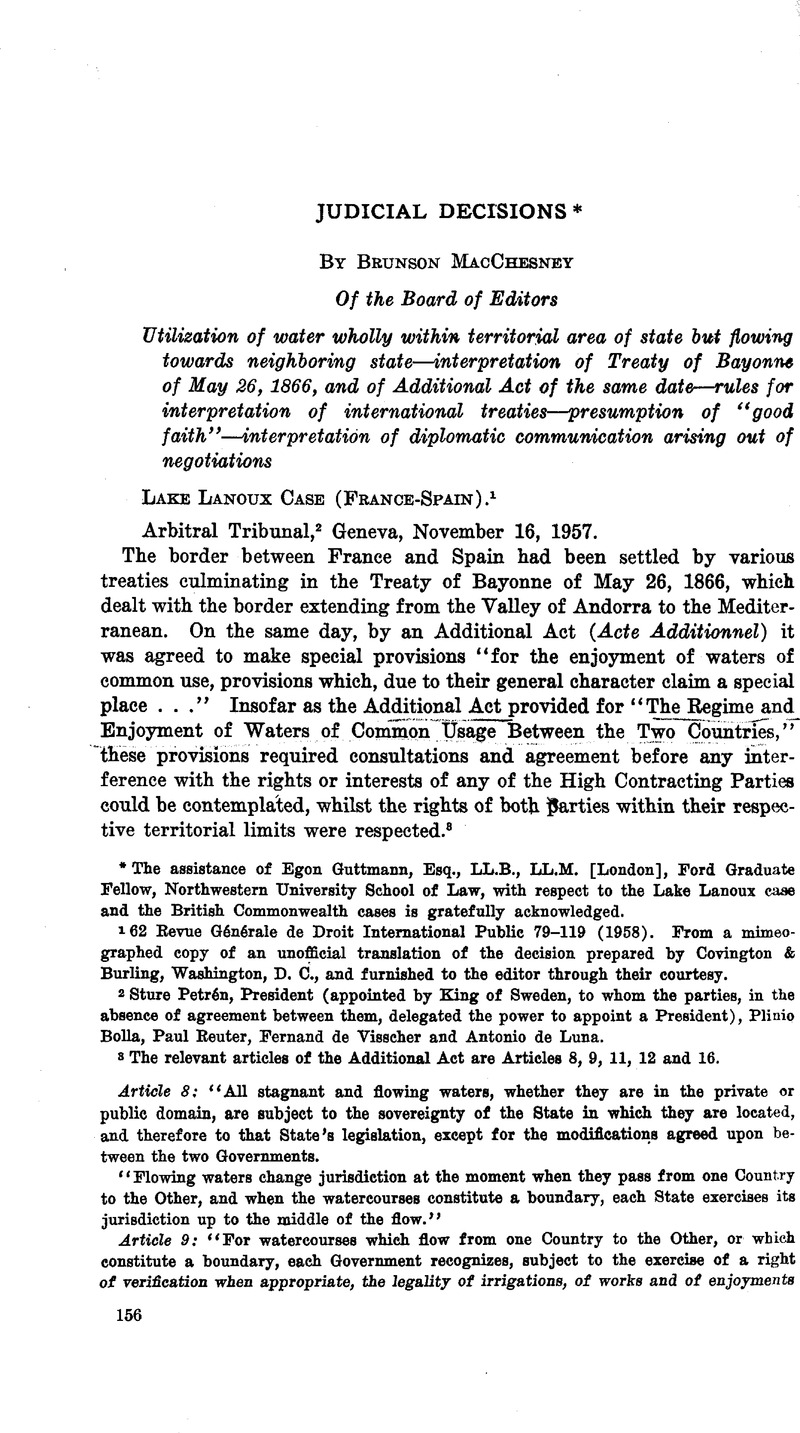Article contents
Lake Lanoux Case (France-Spain)*
Published online by Cambridge University Press: 28 March 2017
Abstract

- Type
- Judicial Decisions
- Information
- Copyright
- Copyright © American Society of International Law 1959
Footnotes
The assistance of Egon Guttmann, Esq., LL.B., LL.M. [London], Ford Graduate Fellow, Northwestern University School of Law, with respect to the Lake Lanoux case and the British Commonwealth cases is gratefully acknowledged.
References
1 62 Revue Générale de Droit International Public 79-119 (1958). From a mimeographed copy of an unofficial translation of the decision prepared by Covington & Burling, Washington, D. C, and furnished to the editor through their courtesy.
2 Sture Petrén, President (appointed by King of Sweden, to whom the parties, in the absence of agreement between them, delegated the power to appoint a President), Plinio Bolla, Paul Reuter, Fernand de Visscher and Antonio de Luna.
3 The relevant articles of the Additional Act are Articles 8, 9, 11, 12 and 16.
Article 8: “All stagnant and flowing waters, whether they are in the private or public domain, are subject to the sovereignty of the State in which they are located, and therefore to that State's legislation, except for the modifications agreed upon between the two Governments.
“Flowing waters change jurisdiction at the moment when they pass from one Country to the Other, and when the watercourses constitute a boundary, each State exercises its jurisdiction up to the middle of the flow.”
Article 9: “For watercourses which flow from one Country to the Other, or which constitute a boundary, each Government recognizes, subject to the exercise of a right of verification when appropriate, the legality of irrigations, of works and of enjoyments for domestic uses currently existing in the other State, by virtue of concession, title or by prescription, with the reservation that only that volume of water necessary to satisfy the real needs will be used, that abuses must be eliminated, and that this recognition will in no way injure the respective rights of the Governments to authorize works of public utility, on condition that legitimate compensation is made.”
Article 11: “When in one of the two States it is proposed to construct works or to grant new concessions which might change the regime or the volume of a watercourse whose lower or opposite part is being used by riparians of the other Country, prior notice will be given to the highest administrative authority of the Department or of the Province to which these riparians are subject, by the corresponding authority in the jurisdiction where such projects are proposed, so that, if they could threaten the rights of the riparians of the adjoining sovereignty, a timely complaint may be lodged with the competent authorities, and thereby all the interests that may be involved on both sides will be safeguarded. If the work and concessions are to be erected in a Commune contiguous to the border, the engineers of the other Country will have the option, upon proper notice given to them reasonably in advance, of inspecting the site together with those in charge of it.”
Article 12: “The downstream lands are subject to receiving from the higher lands of the neighboring Country the waters which flow naturally from it together with what they carry, without the hand of man having contributed thereto. There may be constructed neither a dam, nor any obstacle capable of harming the upper riparians, to whom it is likewise forbidden to do anything which might increase the burdens attached to the servitude of the lower lands.”
Article 16: “The highest administrative authorities of the bordering Departments and Provinces will act in concert in the exercise of their right to set up regulations for the general interest and to interpret or modify their regulations whenever the respective interests are at stake, and in case they cannot reach agreement, the dispute shall be submitted to the two Governments.”
4 Created after an exchange of notes between the French and Spanish governments in 1875.
- 4
- Cited by


